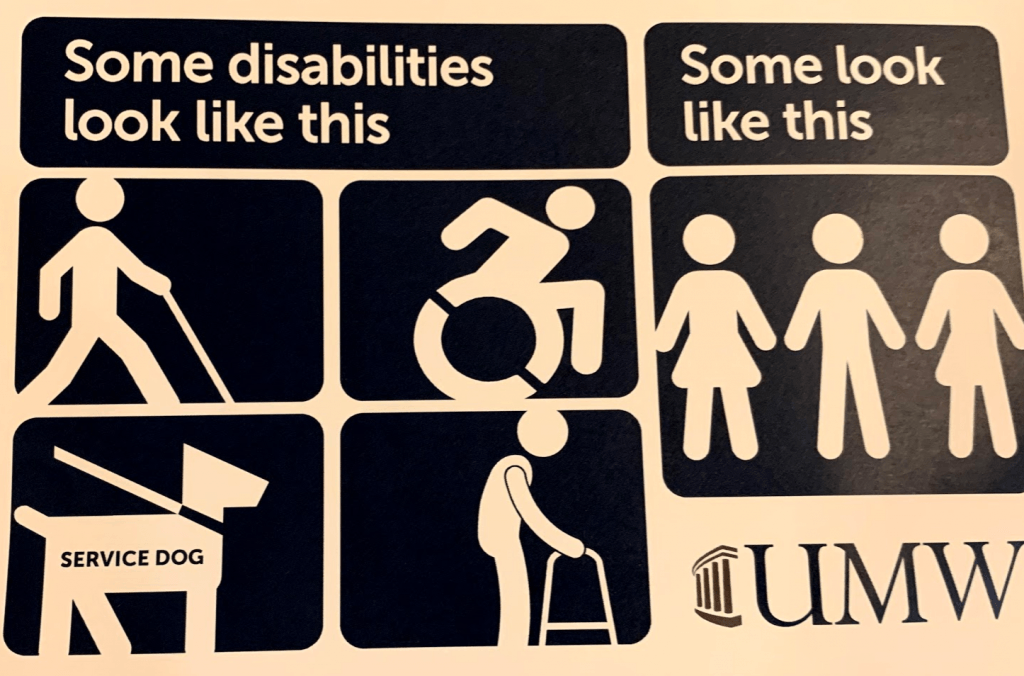Campus accessibility issues addressed during disability awareness events
4 min read
Abigail Buchholz / The Blue and Gray Press
by KATE SELTZER
News Editor
Mary Washington is celebrating disability awareness this month. UMW has the highest represented population of students with disabilities of any public Virginia university, according to Jessica Machado, director of the Office of Disability Resources.
Students with disabilities make up about 11 percent of the student population, more than double the statistic at other universities, she said.
“We have a huge number of students with disabilities that are attracted to our campus, which is wonderful,” Machado said. “We’re doing something right.”
Despite these successes, a large portion of the campus community remains unaware of the services and supports available for students with disabilities.
“Often I think we see a reaction from folks on our campus to refer to an office like ours for any disability-related need without an understanding and awareness of what might be an appropriate type of response, even just being to engage and interact and try to learn more,” said Machado. “There’s kind of a knee jerk reaction to refer.”
The Disability Awareness table fair on Oct. 16 included representatives from campus and community organizations who shared information about resources that can be useful to students with disabilities.
“We just really feel strongly that there’s more awareness that’s needed, and so we’re doing what we can with the limited staff and resources that we have to try and educate the community by doing events like this, the disability awareness table fair,” Machado said.
Writing Center tutors Katia Savelyeva and Mady May represented the Writing and Speaking centers at the event.
“We want to put it out there that the Writing and Speaking Center is an accessible place for anyone, regardless of their learning needs,” said Savelyeva, a sophomore English major. “We’re also always thinking about accessibility as a physical space.”
“We all looked at the suite with a Universal Design lens and asked ourselves how we could be more accommodating and more welcoming,” said Gwen Hale, director of the Writing Center. “We examined space in order to ensure folks could navigate the spaces with or without walkers, crutches, wheelchairs and so forth. One of the student workers for ODR wrote up a proposal for us on how to make the space more comfortable for people who may not have disabilities, but it would be universally helpful for everyone. We now have floor sitting pillows, adjustable desks, and even adjustable footstools.”
The Writing Center also offers readers that enlarge text and computers that allow students to work in a quiet space so they can listen to their e-readers.
“Ultimately, however, the biggest service we offer are employees who are kind and willing to assist and learn,” Hale said. “Still, while we are always looking to ODR and others to help us be better, we are always improving and love when students help us improve organically from within.”
Disability Resource Center intern, Julie Macdonald, worked the DRC table at the fair.
“We are the center for independent living for the Rappahannock area, helping people with disabilities live as independently as they can in an inclusive community,” said Macdonald.
Kaila Lohn, a case manager at the DRC in Fredericksburg, said, “We’re here to help and connect people to services, whether it’s here with us at the DRC or another agency can help them.”
The Fredericksburg Department of Aging and Rehabilitative Services (DARS) also tabled at the event. The state agency works to help individuals with disabilities find employment.
“Don’t hesitate to reach out to our office, even if you’re a freshman,” said Shana Chance, a job placement counselor at the Fredericksburg DARS. “There are services and supports we can offer along the way prior to a person graduating, and then they will be already working with us once they graduate and we can help support them with finding employment.”
The resources offered by the organizations featured at the table event are especially valuable for students with disabilities due to limited resources within ODR.
ODR has three professional staff members: Machado, the assistant technology coordinator and the associate director.
“As far as organized support and resources that are devoted to protecting the rights of individuals with disabilities on our campus and providing supports and services, that’s pretty limited given the high need of our campus,” Machado said. “We’re also a beautiful historic campus, but with that comes some challenges when it comes to physical accessibility.”
Accessibility issues for individuals with physical disabilities include a hilly campus, old buildings and inconsistent Wi-Fi connection necessary for some communication services.
Machado said there is a need for everyone on campus to be involved in making UMW welcoming and accessible.
“Because of this great need of our community and limited resources and support, we really do rely on everybody to be aware of their responsibilities around accessibility,” she said. “When you think about how to support a diverse and inclusive community, that involves every member of our community.”
Other events for Disability Awareness Month include a talk entitled “Nothing About Us Without Us: Autistic Rights and Representation” on Oct. 18 and a fall social for students with disabilities on Oct. 30.
“We would love for the community to kind of come together and take advantage of opportunities to learn more and do better to support this community,” Machado said.
“By having such events on campus, we take away the stigma that some folks may have been brought up with,” Hale added. “We also see the value that everyone brings to campus.”



1 thought on “Campus accessibility issues addressed during disability awareness events”
Comments are closed.